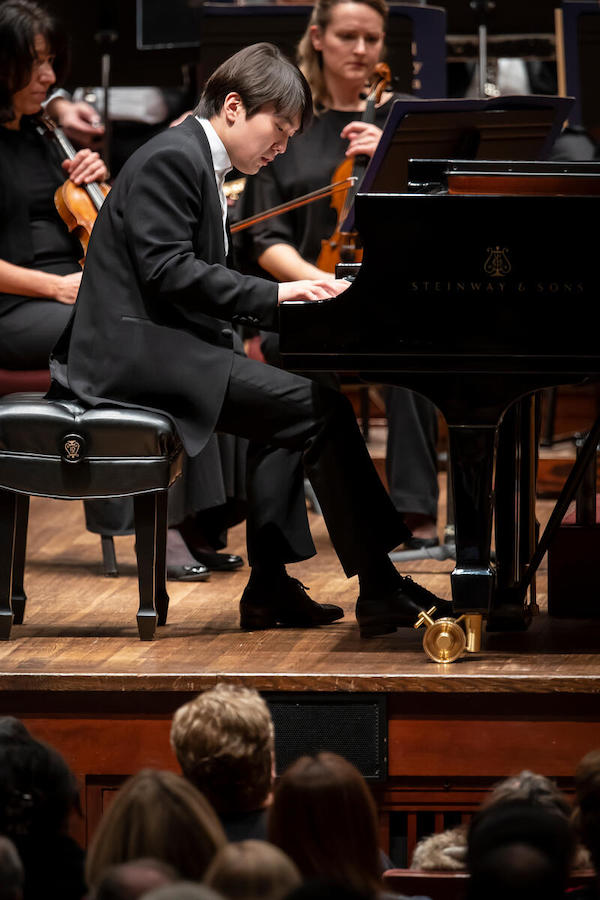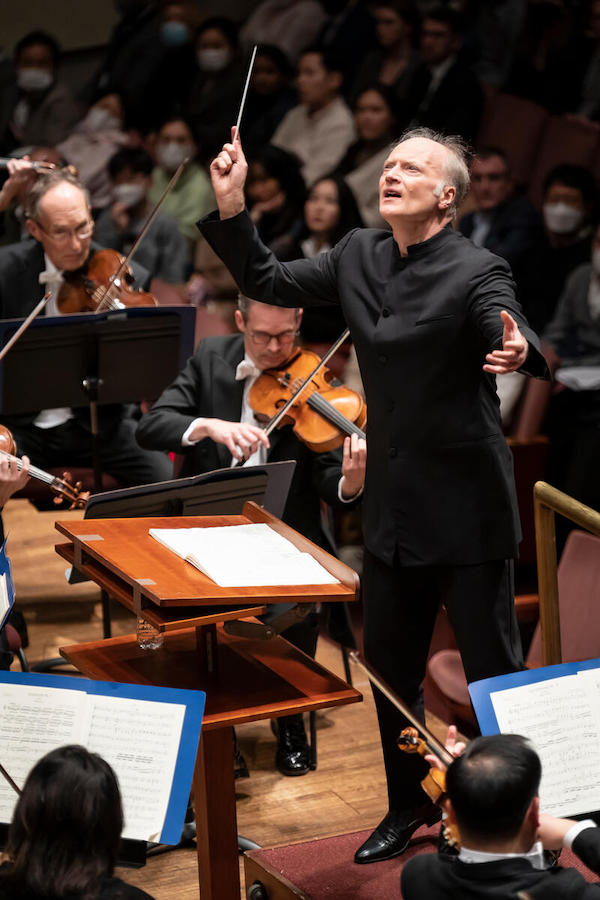Cho delivers blockbuster Brahms with Noseda, National Symphony

Seong-Jin Cho performed Brahms’ Piano Concerto No. 1 with Gianandrea Noseda and the National Symphony Orchestra Thursday night at the Kennedy Center. Photo: Scott Suchman
A rare aura of classical music celebrity hung about the Kennedy Center Concert Hall for the National Symphony Orchestra’s first concert of 2023 on Thursday evening. A capacity crowd turned out to hear the return of Seong-Jin Cho, who has amassed a devoted following since winning the gold medal at the International Chopin Piano Competition in 2015.
The South Korean pianist, now 28, last played with the NSO in 2019; the coronavirus closures canceled his 2020 performance of Shostakovich’s Piano Concerto No. 1. In the last six years, he has formed a strong musical partnership with Gianandrea Noseda, having recorded both Chopin concertos with him. In this appearance with the NSO, Cho performed the Piano Concerto No. 1 of Johannes Brahms.
Brahms began to compose this concerto soon after the suicide attempt in 1854 of his mentor, Robert Schumann, whose Third Symphony was performed on the second half. Brahms had first visited the Schumanns only the previous year, where he was received as a musical hero at age 20. Brahms completed the concerto in 1856, not long after Schumann’s death in a sanatorium, where the elder composer was being treated after his suicide attempt. Though there is no direct program, something of that turmoil seems to be reflected in the surging turbulence of the music.
Noseda opened the first movement with impressive force, his arms slicing through the air to encourage the hammered accents and furious trills of the orchestral introduction. Cho’s interpretation of the solo part emphasized his strengths, especially the interior reflection of the second theme. The pianist’s finesse gave elegant turns to the many scalar and arpeggiated runs, intertwining beautifully with longing themes from horn, oboe, and the first two violins.
Cho’s gossamer touch at the keyboard gave a vulnerable sense of submerged emotion to the second movement. The highlight of Cho’s pianistic arsenal, absolutely flawless trills, capped this gorgeous lament.
Cho dove into the finale’s opening, disrupting the serenity of the previous movement’s last chord. The only minor element missing was the ultimate degree of power in the forte end of the piano, which lacked only at major climaxes. Noseda kept the orchestra with Cho at every step, making for a thrilling finish.
Responding to generous ovations, Cho offered a single encore in Brahms’s Capriccio in B Minor (Op. 76, no. 2). Although initially it seemed an odd choice, the piece’s complexity again showcased Cho’s striking ability to shape cascades of delicate notes into carefully contoured, expressive phrases.

Gianandrea Noseda led the NSO in Schumann’s Symphony No. 3 “Rhenish” Thursday night., Photo: Scott Suchman
In a brief introduction to the concert, Noseda drew attention to the connections between the two works on his program. Schumann conducted the premiere of his Third Symphony in Düsseldorf in 1851, a high point in his otherwise disastrous tenure as conductor in that city. The work’s nickname, “Rhenish,” marks it as a sort of souvenir album of a trip through the Rhineland that the composer took with his wife, Clara.
Noseda’s interpretation was strongest in the first two of the five movements. The boisterous opening bars marked the first movement with enthusiasm, kept crisp by the Italian conductor’s precise gestures. Excellent horn sound blared at climactic moments, especially in the coda. The second movement, which opens with a folksy Ländler-like tune, had a delightfully earthy quality, matched by the enigmatic smooth brass lines of the Trio section.
Impatience undermined the third and fourth movements, where slower tempi and a little more flexibility in rubato may have yielded better results. The third movement, even so, had a well-balanced wind sound, shaped and articulated with alacrity. The three trombones opened the fourth movement with impressive solemnity. Reportedly inspired by a liturgical ceremony the Schumanns witnessed in Cologne’s Gothic cathedral, the music seemed to pick up in tempo, losing its grandiloquent edge a bit, in spite of excellent brass playing.
Noseda’s assured hand made the fifth movement a forthright conclusion, with the horns and trumpets adding spark to the louder sections. Toward the end, the trombones returned to the texture triumphantly, making for a grand ending. It is sobering to recall that just three years after this optimistic symphony’s premiere, Schumann attempted to end his own life by leaping from a bridge into the very river whose beauty it describes.
The concert was an auspicious beginning for the tenure of the NSO’s new executive director, Jean Davidson, whose appointment was announced on Wednesday. She comes to Washington from her position as president and CEO of the Los Angeles Master Chorale. Davidson replaces Gary Ginstling, who departed last October to become executive director of the New York Philharmonic.
The program will be repeated 8 p.m. Friday and Saturday. kennedy-center.org
